From open arms policy to the street: The collapse of New York migrant shelters
The thousands of people living in shelters set up by the city, which has received nearly 200,000 immigrants since 2022, denounce the lack of a long-term plan. Since last week, the situation has worsened with cuts to the maximum length of stay


The sidewalk in front of the Row Hotel on Manhattan’s Eighth Avenue is crowded with New Yorkers and tourists gearing up to view the April 8 solar eclipse. Everyone clutches camaras and glasses, except Hedgie. She is on a street corner, nearly hidden by the crowds. Around her are several backpacks, suitcases, bags of clothes. The 30-year-old Ecuadorian is waiting for her husband to help her carry their belongings to the subway. Today they must leave the hotel, which for the last two months has served as their shelter.
The family of four — they have two children, four and eight years old, all of them undocumented — will now live in the Watson Hotel, which is also located in Manhattan, until June, at which point they will be displaced yet again and have to apply for housing in one of the shelters run by New York City for the thousands of migrants who have arrived since the spring of 2022. Over the six months they have been in the city, the family has had to move four times. Hedgie says that they are tired of going from here to there, and that they are considering going to another state: “We don’t want to be here anymore.”
Like Hedgie, thousands of people housed in the more than 215 shelters administered by the city to deal with the nearly 200,000 migrants who have arrived in the Big Apple since 2022 have received eviction notices since last October, when the city began to restrict length of stay at the facilities. Since last week, the situation has worsened due to new restrictions that limit housing applications. Under the new regulations, which were announced in March, families with children like that of Hedgie must apply for shelter every 60 days. But couples without children and single people will only be eligible for stays of 30 days and then will have to leave the shelters, unless the city determines that they have “extenuating circumstances” and grants them an extension. Until now, these last two groups were limited to stays of 30 days, but they could re-apply every month.
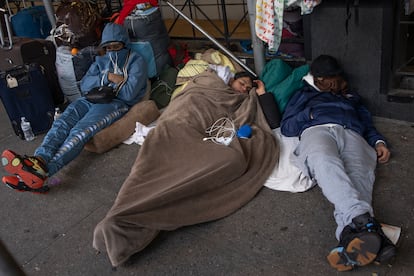
With these new rules, the city’s Democratic Mayor Eric Adams is aiming to force migrants to find housing on their own and reduce the number of people within the shelters. But immigration advocates say that the new regulations will only intensify the desperation that migrants are already feeling, forcing them to live in a constant state of worry and instability. Many will wind up sleeping on the street since most of them don’t have a source of income and are not allowed to work due to their immigration status. They way things stand, they already can’t cover the cost of rent in one of the country’s most expensive cities.
Kim Corona, spokesperson for the New York Immigration Coalition (NYIC), which is comprised of pro-migrant and refugee organizations, calls the new restrictions “discriminatory.” “These limits are inhumane. No one should run the risk of winding up sleeping in the street,” she says. Corona underlined the burden that the new restrictions will mean for families: “Making families with children re-apply for housing once their 60 days are up is a continuous cycle that keeps people in short-term places without the long-term solutions they really need. It also affects children: having to move to another spot messes up their education and learning; it’s an interruption.”
More than 70% of migrants who have passed through these facilities over the last two years are from Latin America. The majority come from Venezuela (41%), Ecuador (17%) and Colombia (9%), according to numbers provided by the city. Many of them emigrated from their countries bound for New York after having read on social media or heard from family members or friends that in the city there is a law called “right to shelter” that has been in place since the 1980s. This law, which does not exist in other large U.S. cities, guarantees a bed to anyone who asks for one in a network of shelters. For four decades, the right to shelter has been principally oriented towards the homeless population. That changed in spring of 2022, when thousands of migrants learned of its existence. In the spring of 2023, the number of migrants who lived in the shelters exceeded the number of homeless individuals.
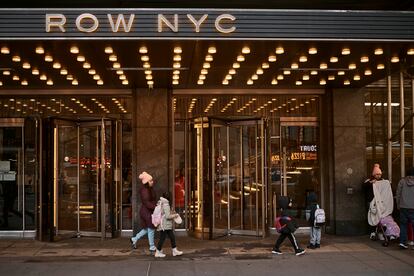
Initially, Adams’s administration received the recently arrived migrants with open arms. When the governor of Texas, Republican Greg Abbott, began to send buses filled with migrants to New York as part of a political maneuver to protest Joe Biden’s immigration policy, Adams himself went to the terminal where the first buses arrived to welcome them. But the buses kept coming — Abbott has sent more than 37,100 migrants to New York since August 2022 — and soon, the shelter network began to collapse. Though the city opened more facilities and beds, the overflow led Adams’s administration to turn off supply: first he tried to restrict the right to shelter in 2023 and then he sought to suspend it entirely.

After months of negotiations between authorities and organizations who support the right to shelter, all parties arrived at an agreement last March to keep the law in place, with certain exceptions. Beginning May 22, the city would send out eviction notices every 60 days to families and every 30 days to single adults, who would not be allowed to re-apply for housing, unless they fit into one of several exemption categories (these include being able to prove that they will leave the city within 30 days or have signed a contract to move into their own apartment within the same time period). As of April, the last month for which the city has released figures, there were 65,000 migrants living in the shelters. Of them, 78% were families with children. The rest — nearly 15,000 people — could be evicted in the next few months.
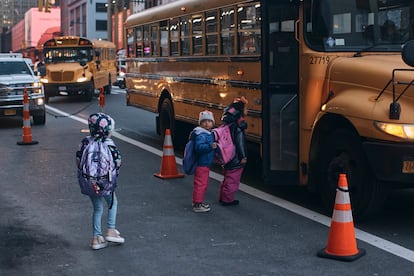
“The only solution,” says the NYIC’s Corona, is for the government to prioritize helping migrants to find permanent housing, instead of forcing them to move from one shelter to the next. To do that, organizations like NYIC have demanded that Mayor Adams and Governor Kathy Hochul (also a Democrat) widen city and state housing assistance programs for undocumented immigrants. One of these programs is CityFHEPS, which helps beneficiaries living in New York City to receive a monthly rent supplement. As of now, undocumented migrants are not eligible for its services.
According to a study carried out by NYIC and the organization Win, the largest provider of shelters and housing for houseless families and individuals in New York City, the Adams administration would save $2.9 billion a year if migrants could be moved to permanent housing instead of city shelters. The organizations estimate that if the city included migrants in the CityFHEPS program, it would pay $72 a night for a two-bedroom apartment for a family seeking asylum, compared to the $383 on average that is spent on housing a family for one night in a hotel that has been converted into a shelter. The report was published in August 2023, when there were 57,000 migrants living in city shelters, compared to the 65,000 that are currently housed by the system.
At Make the Road New York, the largest immigrant organization in the state, they agree that widening programs like CityFHEPS should be the priority. Yaritza Mendez, the group’s co-director of organizing, says that the city “has to do a better job” and “open more doors” so that thousands of migrants can get out of the shelter system and access permanent housing. The new regulation “does little more than exacerbate the crisis because people don’t have anywhere to go,” she says.
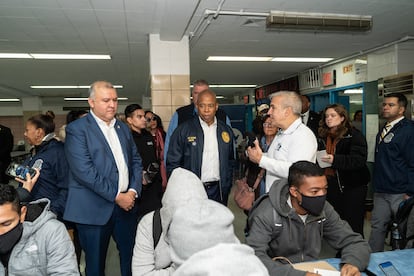
Trapped in a “vicious circle”
EL PAÍS visited several of the city’s shelters, and though inside access was not permitted, testimony collected at the doors of the centers revealed that the people who live inside them feel trapped in a “vicious circle” from which it is difficult to leave. Though all interviewees communicated their gratitude for having a place to sleep every night, they feel that the city has no long-term plan to help them achieve stability and self-sufficiency. Make the Road’s Mendez describes it as a “chicken and egg situation.” “These people have not been able to find a permanent place to live” and as a result, remain in the shelters “because they haven’t been able to find a stable job due to their migratory status,” she says.
This is the cycle in which Maryelys García has found herself. The 35-year-old Venezuelan has been in the Big Apple for five months and is waiting for the resolution of her request for asylum, a process that can take between six months and several years. Asylum seekers can apply for a 180-day work permission, but the wait to receive a response can take months or more than a year. While García waits for a response to her application, her only option is to continue to live in the city’s shelters because during the journey to the United States, “they stole everything” from her and she doesn’t have enough money to rent a room that costs more than $1,000 a month.
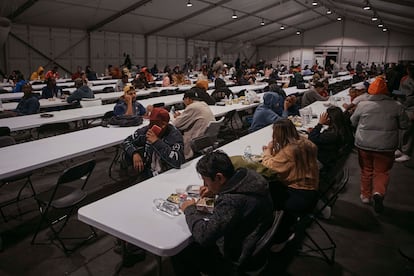
For now, she lives in the Row Hotel in Manhattan, where she shares a bedroom and a bathroom with her friend and the friend’s daughter, who emigrated from Venezuela with her. The three were able to be designated as a family by the city, and thanks to this, they have been assigned 60-day lengths of stay. They received their last extension on May 20 and will continue at the Row until at least mid-July, when they will have to apply again.
In the streets surrounding the hotel, García sells “little things”: food, secondhand cell phones, etc. She also puts in a few hours at a restaurant that allows her to work for money under the table. The small amount of money that she makes, she saves. Her dream is to be an entrepreneur: “We didn’t come looking for a handout, we want to work for what is ours. My dreams are big, but give me a chance,” she says.
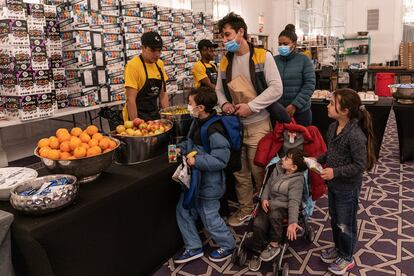
When it comes to living conditions within the Row Hotel, the Venezuelan says there are a lot of “cockroaches and ants.” She says that she has not seen rats or mice in her room, but she’s sure they are there because the “garbage builds up in the hallways.” Aside from the filth, García complains about the food: “We give thanks because we are not hungry, but every day it’s the same thing. If you stay for three months here, you’re going to eat the same thing for three months.”
Miguel says that in the Stewart Hotel, which is also located in Manhattan, the situation is similar. The 36-year-old Venezuelan man prefers not to use his real name, because he fears he’ll be expelled from the shelter system. In the entryway of the Stewart, he whispers his complaints: “There are a lot of chiripas [cockroaches].” Miguel has been in New York for a year, trying to file his petition for asylum and work permit. Together with his wife and children, who are eight and 12 years old, he has lived in three different shelters. “We’ve been living off the government for a long time now, and that’s not why we came here.” He says that when he receives his permission to work, they will leave New York.
In addition to hotels that have been turned into shelters, the city has also built camps to house migrants. One of them was constructed on the Floyd Bennet Field, in the southeast corner of Brooklyn. On land that previously housed an airport live nearly 2,000 people — 500 families with children — in a small city formed by several gigantic tents. Within the tents, the space is divided into hundreds of modules where families sleep in cots. Bathrooms and showers are outside, in separated trailers.
The migrants who live here say that to file any application, they have to leave the camp at dawn, especially if they have to go to Manhattan. Floyd Bennet Field is located in a remote area of Brooklyn, almost completely surrounded by Jamaica Bay, near Rockaway Beach. The closest subway station is almost five-and-a-half miles away and it takes two hours to get to Manhattan on public transportation. This is the temporary home of Carlos, a 36-year-old Ecuadorian man who also doesn’t dare to give his real name and who arrived with his wife and two daughters. Although he doesn’t have permission to do so, he works at a mechanic’s garage in Queens and says it takes him two hours to get there, depending on traffic. He works for 12 hours a day, but says that between his family’s expenses and the debt he has waiting for him back in his own country, he has not earned enough money to save, much less pay rent.
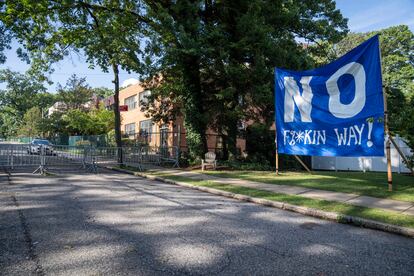
Carlos and his family left the city of Quito last November. “My wife had a hair and nails salon. One day they came and told us that we had to pay a monthly fee or they would kill us. We ignored them, but they came back. We ignored them again until one day they shot at our house, they even killed our cat.” They have been at the Floyd Bennett Field for four months, and say that living there is not easy. They say the shared bathrooms are always dirty because “people relieve themselves wherever” and the food is terrible. Even so, they have no other option besides filing one application after another to live there, or in another shelter, until their asylum request is resolved.
When asked if they want to stay in New York or go to another state, Carlos replies: “I don’t know … Right now, we only want to leave here and have our own space.”
Sign up for our weekly newsletter to get more English-language news coverage from EL PAÍS USA Edition
Tu suscripción se está usando en otro dispositivo
¿Quieres añadir otro usuario a tu suscripción?
Si continúas leyendo en este dispositivo, no se podrá leer en el otro.
FlechaTu suscripción se está usando en otro dispositivo y solo puedes acceder a EL PAÍS desde un dispositivo a la vez.
Si quieres compartir tu cuenta, cambia tu suscripción a la modalidad Premium, así podrás añadir otro usuario. Cada uno accederá con su propia cuenta de email, lo que os permitirá personalizar vuestra experiencia en EL PAÍS.
¿Tienes una suscripción de empresa? Accede aquí para contratar más cuentas.
En el caso de no saber quién está usando tu cuenta, te recomendamos cambiar tu contraseña aquí.
Si decides continuar compartiendo tu cuenta, este mensaje se mostrará en tu dispositivo y en el de la otra persona que está usando tu cuenta de forma indefinida, afectando a tu experiencia de lectura. Puedes consultar aquí los términos y condiciones de la suscripción digital.
More information
Archived In
Últimas noticias
Most viewed
- Sinaloa Cartel war is taking its toll on Los Chapitos
- Oona Chaplin: ‘I told James Cameron that I was living in a treehouse and starting a permaculture project with a friend’
- Reinhard Genzel, Nobel laureate in physics: ‘One-minute videos will never give you the truth’
- Why the price of coffee has skyrocketed: from Brazilian plantations to specialty coffee houses
- Silver prices are going crazy: This is what’s fueling the rally










































